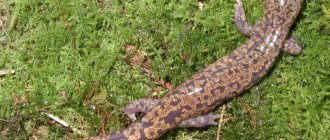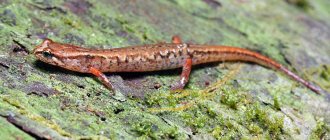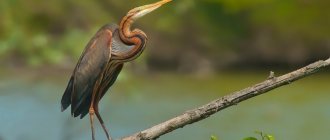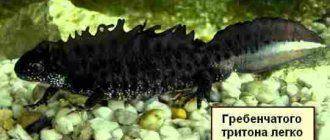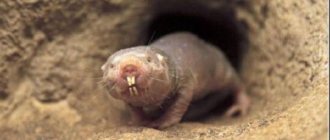- Wild animals
- >>
- Amphibians
The salamander is an amphibian, which in ancient times people were very afraid of, they composed legends about it, revered it, and also attributed magical abilities. This was due to the appearance of the salamander and its behavior. For a long time, people believed that animals do not burn in fire because they themselves are made of fire. Indeed, translated from the language of the ancient Persians, salamander means “burning from the inside.”
Origin of the species and description
Photo: Salamander
In their appearance, salamanders strongly resemble lizards, but zoologists classify them into different classes: lizards into the reptile class, and salamanders into the amphibian class, the genus salamander.
In the process of evolution, which lasted millions of years, all representatives of the genus were divided into three main groups:
- real salamanders (Salamandridae);
- lungless salamanders (Plethodontidae);
- cryptobranch salamanders (Cryptobranchidae).
The differences between all three groups are in the respiratory system, which is structured completely differently. For example, the first breathe with the help of lungs, the second with the help of mucous membranes and skin, and the third with the help of hidden gills.
Video: Salamander
The body of salamanders is elongated, smoothly turning into a tail. Amphibians range in size from 5 to 180 cm. The skin of salamanders is smooth to the touch and always moist. Their color range is very diverse depending on the species and habitat: yellow, black, red, olive, green, purple. The back and sides of animals can be covered with large and small spots, stripes of various colors.
Interesting fact: The smallest salamanders in the world are the dwarf Eurycea quadridigitat with a body length of up to 89 mm, and the very tiny Desmognathus wrighti with a body length of up to 50 mm. And the world's largest salamander, Andrias davidianus, living in China, reaches a length of up to 180 cm.
Salamanders have short and stocky legs. The front limbs have 4 fingers, and the hind limbs have 5. There are no claws on the fingers. The head is flattened, similar to the head of a frog, with bulging and, as a rule, dark eyes with movable eyelids.
In the skin of animals there are special glands (mumps) that produce poison. The venom of salamanders is usually not fatal, but if you try to eat it, it can paralyze the predator for some time and also cause convulsions in it. Salamanders live almost everywhere where the climate is warm and humid, but the greatest diversity of species can be found in North America.
Appearance and features
Photo: What a salamander looks like
All salamanders are very similar to each other in appearance: they have an elongated body with smooth slimy skin, a rather long tail, not very developed limbs without claws, a small head with bulging black eyes and movable eyelids, allowing you to examine the surroundings without turning your head. The jaws of amphibians are poorly developed, since they are not at all adapted to eating hard food. Because of their clumsiness, animals feel much more comfortable in water than on land.
Salamanders, unlike their closest relatives - lizards, are also very interesting with their variety of colors in literally all the colors of the rainbow. As usual in nature, behind the bright and spectacular appearance lies a danger - a poison that can burn and even kill. All species of salamanders are poisonous to one degree or another, but only one species of these animals has deadly poison - the Fire Salamander.
In myths and legends composed in ancient times, the salamander has always been assigned the role of a servant of dark forces. This prejudice existed partly because of the unusual appearance, but also because of the ability, in case of danger, to produce a poisonous secretion from the skin, which could both cause a severe burn to the skin (in humans) and paralyze or even kill (smaller animals).
Now you know whether the salamanda is poisonous or not. Let's see where this amphibian lives.
Interesting Facts
- The fire salamander, like all species from this family, has a toxic venom that is found on the surface of its skin. It is secreted by the parotid glands, and this process occurs constantly. The peculiarity is that if, for example, a dog eats a salamander, it will soon die.
- The poison of these animals is called salamandrin in chemistry. It is really dangerous for humans only when consumed internally, which is why the use of these amphibians as food is prohibited. It is also noteworthy that they use their poison exclusively for the purpose of self-defense, and not for hunting.
- The giant salamander prefers to be in water, or to be more precise: in cold and fast-flowing mountain streams. And, despite its large size, this animal does not disdain to feed on insects and crustaceans, alternating them with fish. The activity period of this species is at night.
- All salamanders have the ability to regenerate not only the tail, but also the rest of the limbs. In this feature they resemble lizards, but in this factor they are also ahead of them in development.
- They say the fire (spotted) salamander only reproduces when there is a strong thunderstorm. Similarly, during riots, ignorant people try to achieve some position in society.
- According to German mythology, this family of amphibians personifies the spirit of fire. Moreover, the Germans in their stories attribute to salamanders the ability to tolerate combustion temperatures without any damage. From the point of view of the Christian faith, these creatures are messengers of the devil. And indeed, judging by the way the salamander looks, one might get such an impression.
- Many species are listed in the Red Book as they are endangered. This is due to the fact that animals are hunted to obtain poison. And in certain countries their meat is considered a delicacy.
- The official symbol of Alabama (USA) is the burrow salamander.
- On sunny days, the amphibian does not leave the cool and dark shelter. Those who plan to commit a crime under cover of night behave in a similar way.
- The salamander is not a lizard, but belongs to the class of amphibians. In the same way, one should not confuse foul language with a demon from the depths of hell.
- If hair falls out from the venom of a spotted salamander, then a person’s honor and good name are lost from slander.
- Beautiful spots on the back of an animal can symbolize hypocrisy, which always wears an attractive mask.
Video
Where does the salamander live?
Photo: Salamander in Russia
The habitat of salamanders is quite extensive. To summarize, they live almost everywhere, on all continents, where there is a warm, mild and humid climate without sharp changes in seasonal, day and night temperatures. However, most species can be seen in North America.
Alpine salamanders, of course, live in the Alps (eastern and central parts of the mountains), and they can be found at altitudes of up to 1000 m above sea level. Salamanders are also quite common in Switzerland, Austria, Italy, Slovenia, Croatia, Bosnia, Serbia, Montenegro, Herzegovina, southern France, Germany and Liechtenstein.
There are species that live in a very limited area. For example, the Lanza salamander lives exclusively in the western part of the Alps, literally on the border of Italy and France, in the Chisone valley (Italy), in the valleys of the Po, Gil, Germanasca, and Pellice rivers.
Many species of a wide variety of salamanders are found in Western Asia and throughout the Middle Eastern region - from Iran to Turkey.
Interesting fact: The Carpathians are home to one of the most poisonous salamanders - the alpine black salamander. Animal venom, released through the skin through special glands, causes very severe burns on the skin and mucous membranes, which do not heal for a very long time.
Spreading
Lives in Europe from Spain and Portugal in the west to western Russia, Turkey and Israel in the east. Some salamanders live exclusively in water and differ from their relatives by well-formed gills, for example, the Chinese giant salamander is a representative of the cryptobranch . Salamanders belonging to the family of cryptobranchs live in the United States of America, China and Japan.
the family of lungless salamanders completely lost their lungs without gaining gills. Therefore, members of the family have to breathe using the skin and mucous membranes of the mouth. These salamanders live in tropical and subtropical forests, in mountains and lowlands, on plantations and in village gardens. Lungless salamanders are inhabitants of predominantly New World countries: they are distributed in areas covering the mountainous and forested areas of Canada, including the tropics and subtropics of Bolivia and Brazil. Several species live in European countries, and only one species (lat. Karsenia koreana) can be found in South Korea.
Representatives of the family of true salamanders , leading a predominantly terrestrial existence, have a respiratory system represented by a pair of well-developed lungs. True salamanders are widespread throughout Europe, living in the north-west of the African continent, Asia Minor and China, small species populations are found in Indochina and India, the range also covers areas from southern Canada to the northern regions of Mexico. Only four species of salamanders live in Russia.
What does a salamander eat?
Photo: Black salamander
What salamanders eat depends mainly on their habitat. For example, small amphibians living on land hunt flies, mosquitoes, butterflies, spiders, cicadas, earthworms, and slugs. Larger salamanders prefer to hunt small lizards, newts, and frogs. Animals living in reservoirs catch crustaceans, mollusks, small fish, and fry.
When climatic conditions permit, amphibians can hunt all year round. The period of greatest activity of salamanders occurs at night. In the dark, they come out of their hiding places to walk and hunt, and they can do this from the evening until dawn.
To catch their prey, they first watch it for a long, long time without moving, thanks to their bulging eyes and moving eyelids. Salamanders catch prey by throwing out their long, sticky tongue. If the animal manages to get closer to the prey unnoticed, then it will probably not be able to escape.
Having caught their prey with a sharp movement, they lean on it with their whole body and try to swallow it whole without chewing. After all, the salamander’s jaws and mouth are not at all suited for chewing. With small animals (insects, slugs) everything turns out simply, with larger prey (lizards, frogs) the animal has to really try. But then the salamander feels full for several days.
Features of character and lifestyle
Photo: Orange salamander
Salamanders move rather slowly, and in general they generally move very little, but mostly sit in one place, lazily examining their surroundings. Animals are most active at night, and during the day they try to hide in abandoned holes, old stumps, in thick grass, in piles of rotten brushwood, avoiding direct sunlight.
Salamanders also hunt and breed at night. There must be at least some kind of body of water near their habitat. After all, salamanders cannot live without water, and all because their skin quickly dehydrates.
If salamanders do not live in the tropics, then their wintering season begins in mid-autumn, which, depending on the region where they live, can last almost until mid-spring. At this time, their home is deep abandoned holes or large piles of fallen leaves. Salamanders can winter either alone, which is more typical for them, or in groups of several dozen individuals.
In the wild, salamanders have many enemies, so in order to escape, the animals secrete a poisonous secretion that paralyzes the jaws of predators. If this does not help, they may even leave their limbs or tail in their teeth or claws, which will grow back after a while.
Social structure and reproduction
Photo: Salamander eggs
On average, salamanders can live up to 20 years, but their life expectancy depends on the specific species and habitat. Small species of these animals become sexually mature at 3 years, and large ones later - at 5 years.
Cryptobranch salamanders lay eggs, and true salamanders can be either viviparous or ovoviviparous. Amphibians can reproduce throughout the year, but the peak of mating activity occurs in the spring months.
When a male salamander is ready to mate, a special gland swells and is filled with spermatophore—male reproductive cells. He is very excited and the main goal of his life at this moment is to find a female and fulfill the duty of procreation. If there are several contenders for the female’s attention, then the males may fight.
Males release the spermatophore directly onto the ground, and females absorb it through the cloaca. In water, the fertilization process occurs differently: females lay eggs, and males water them with spermatophore.
Fertilized eggs attach to algae stems or roots. In viviparous species, larvae develop inside the womb within 10-12 months. In aquatic salamanders, the young hatch from eggs after about 2 months with fully formed gills. In appearance, the larvae are somewhat reminiscent of tadpoles.
Interesting fact: In viviparous salamanders, out of 30-60 fertilized eggs, only 2-3 babies are born, and the remaining eggs are just food for future offspring.
Salamander larvae live and feed in water for about three months, gradually transforming and acquiring the appearance of adults. Before the completion of metamorphosis, small salamanders crawl a lot along the bottom of reservoirs and often emerge, trying to breathe air. Young individuals have no connections with their parents and upon completion of metamorphosis they begin their independent life.
Keeping at home
These amphibians are kept in a terrarium at home. It is necessary to fill the bottom with soil. It should be a mixture of soil, moss, coal and peat. Salamanders love to burrow into moss. But it dries out quite quickly. Therefore, it needs to be updated periodically. To create conditions as close as possible to natural conditions, it is important to place one more thing in your pet’s house. These are dry driftwood, stones, and it is also good to plant several living plants.
The amphibian enjoys taking baths. Therefore, it is necessary to place a pond in the terrarium. Be sure to keep it clean. Change the water and rinse the container from time to time. It is not recommended to place two males in one house. The ideal option is several females and one male.
The salamander does not tolerate heat very well. Therefore, it is best to place the terrarium in dark places. For lighting, use fluorescent lamps, which must be purchased additionally. Buy a humidifier too. The humidity in the pet's home must be constantly maintained at a level of at least 75%.
It is often not recommended to pick up an amphibian. Animals do not like too much tactile contact. In addition, they secrete a secretion that can cause irritation on the skin. It is important to create a balanced diet for your pet. Despite being kept in captivity, salamanders have an excellent appetite. The main thing is not to overfeed them. You need to give food 2 times a day. Please note that pets may completely refuse to eat for several days, or even weeks. This is normal before shedding and during hot weather.
The main diet of salamanders should consist of live insects. These are slugs, butterflies, beetles, crickets, caterpillars and flies. Sometimes you can give some fresh fish, beef liver or heart - also raw.
Salamander breeding
Puberty in salamanders occurs at the age of two to four years, usually when they reach a length of 12-14 cm. Mating occurs after wintering. Therefore, if you plan to breed amphibians, then they need to create a wintering area artificially - first lower the temperature to +8...+14 degrees, and then (in April) raise it to +18...+23. Plus, you can place more items in the terrarium where the couple can hide. During wintering, food is not offered to amphibians.
Mating begins in April-May. Salamanders are viviparous animals, so 9-10 months after fertilization, the female will lay larvae in the water. The number of larvae can reach 25-30.
Immediately after birth, the babies will need to be placed in a separate aquarium with mandatory aeration and filtration and maintaining a water temperature of +12-17 degrees. The aquarium must have a dry area. The babies need to be fed with corret, cyclops, daphnia, etc. After three to five months, the babies will reach a size of 5 cm and will be able to go onto land.
Health and characteristic diseases
Diseases characteristic of tailed amphibians:
- burns;
- parasites and mites;
- insect bites;
- infected wounds or cutaneous mycosis;
- benign tumors;
- saprolegnia fungus.
If during molting you notice that your salamander is passive and often freezes, there is no need to worry. This is normal during this period. You just need to leave her alone and not pick her up. The amphibian falls into a state of torpor in winter, as well as during bad weather. The salamander is an excellent exotic pet.
Having such a miracle in your home, you will definitely not be bored, because observing the behavior of an exotic animal brings great pleasure. The amphibian feels great in captivity, does not require special care and does not cause any problems in the form of noise, dirt or other discomfort. It can be started by a beginner. You can purchase a salamander for between $15 and $40.
Natural enemies of salamanders
Photo: Salamander in nature
In nature, salamanders, due to their slowness and peculiar variegated bright colors, have many enemies, since they are very easy to notice. The most dangerous of them are snakes, as well as larger poisonous and non-venomous snakes.
It is also better for them not to catch the eye of large birds - falcons, hawks, eagles, owls. Birds usually do not swallow amphibians alive - this is fraught, as you can get a decent portion of poison. Usually the birds grab the salamanders with their claws and kill them by throwing them from a height onto the stones, and only then start eating, unless, of course, no one has stolen the prey, which happens quite often.
Wild boars, martens and foxes are also not averse to feasting on salamanders. Moreover, it is wild boars who manage to hunt them with great success, since these animals have a fairly large mouth, which allows them to quickly swallow the prey before it has time to come to its senses and secrete poison from the skin. Foxes and martens have a much more difficult time in this regard - the prey may have time to paralyze their jaws with poison or escape completely, leaving a paw or tail in its teeth.
In the aquatic environment, salamanders also have many enemies. Any large predatory fish - catfish, perch or pike - can dine on animals, but more often their larvae. Smaller fish are not averse to eating eggs.
Population and species status
Photo: What a salamander looks like
Due to their variability, diversity and vast habitat, zoologists have identified many species and subspecies of salamanders. Previously, seven main species of salamanders were identified, but recent biochemical studies of genetic material have shown that there are only four.
Main types of salamanders:
- Maghreb salamander (Salamandra algira Bedriaga), found and described in 1883 in Africa;
- Corsican salamander (Salamandra corsica Savi), described in 1838 on the island of Corsica;
- the Central Asian salamander (Salamandra infraimmaculata Martens), described in 1885 in Western Asia and having 3 subspecies (with 3 subspecies);
- spotted salamander (Salamandra salamandra) described in 1758, living in Europe and the European part of the former USSR, having 12 subspecies.
Of all the known subspecies, the Fire Salamander is the most studied.
The venom of most species of salamanders is considered not fatal to humans, but at the same time very dangerous, since it can cause severe burns if it comes into contact with the skin. For this reason, holding salamanders in your hand is highly undesirable. In general, salamanders are not very dangerous animals. After all, they never attack people themselves, since they have neither sharp claws nor teeth for this.
Nutrition
The diet of such a tailed amphibian as the salamander depends to a small extent on its species.
Predators among these animals can be counted on the fingers of one hand, while populations of the family are found in all corners of the world.
This is largely due to the underdeveloped jaw and innate laziness of this group. In general, the daily menu of each of its representatives most often includes:
- caterpillars;
- spiders, cicadas and butterflies;
- slugs and earthworms;
- small newts and frogs (the fire salamander especially loves them).
If we talk about larger individuals of these amphibians, then they prefer to use;
- small amphibians;
- fish;
- crustaceans.
This diet is preferred by the giant salamander and some other individuals of this family that live in water bodies. These creatures go hunting at night; during the day their activity is extremely low.
In addition, they prefer not to attack predators, and reduce the likelihood of collisions with potential enemies to a minimum.
In the photo you can see how the giant salamander rested in the man’s arms. This once again challenges the idea that these creatures are capable of eating people.
Interesting! By the way, there is also a myth about the immortality of the salamander. At one time, people were so afraid of these animals that they attributed fantastic abilities to them, so some facts of the past regarding this family are greatly distorted.
